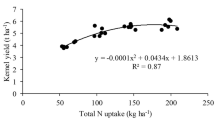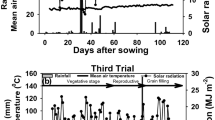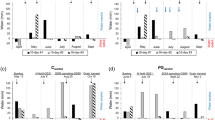Abstract
The major challenge in sustainable rice production is to achieve the goals of increasing crop productivity, profitability, and resource use efficiency. Production systems (PS) and nitrogen (N) management patterns are two key agronomic practices influencing crop performance, profitability, water use efficiency (WUE), and N use efficiency (NUE). So, this study was conducted to check the influence of split application of N on rice productivity, NUE and profitability under dry direct-seeded rice (DDSR) and transplanted rice (TPR) systems. A field study was conducted in the summer season of 2017 and 2018 to investigate the influence of two PS (dry direct-seeded rice = DDSR and transplanted rice = TPR) and six N management treatments (N1 = control, N2 = 50 kg N ha−1 as basal, N3 = 100 kg N ha−1 as basal, N4 = 150 kg N ha−1 as basal, N5 = 100 kg N ha−1 in three splits and N6 = 150 kg N ha−1 in three splits) on crop productivity, profitability, and resource use efficiency. Yield-related traits, spikelet sterility, WUE, and profitability aspects were significantly influenced by PS. All aspects of crop performance, kernel quality, N uptake, and NUE (except NUE on biomass basis = NUEB) were affected by N management pattern, while no significant interaction between PS and N management was observed for any aspect. On average, DDSR improved the productive tiller density (26%), biological yield (16%), WUE (14%), and NUEB (27%) as compared with TPR. Similarly, DDSR reduced the cost of production (31–43%), while maintaining statistically similar paddy yields and reducing total water inputs (5–17%) in comparison with TPR. Among N management pattern, 100 kg N ha−1 in three splits increased paddy yields (44%), and WUE (42%) as compared with the basal application of 100 kg N ha−1. Similarly, application of N at 100 kg ha−1 in three splits improved the total N uptake (42%), agronomic NUE (146%), apparent recovery efficiency (226%) while reducing the spikelet sterility (28%) as compared with the basal application of 100 kg N ha−1. The DDSR has the potential to maintain or increase yield, WUE, NUE, and economic returns. While, split application of N at 100 kg ha−1 either in DDSR or TPR not only increased the SPAD-chlorophyll value, WUE, NUE, and economic returns but also reduced the spikelet sterility.





Similar content being viewed by others
References
Andrews M, Raven JA, Lea PJ (2013) Do plants need nitrate? The mechanisms by which nitrogen form affects plants. Ann Appl Biol 163:174–199. https://doi.org/10.1111/aab.12045
Aziz O, Hussain S, Rizwan M, Riaz M, Bashir S, Lin L, Mehmood S, Imran M, Yaseen R, Lu G (2018) Increasing water productivity, nitrogen economy, and grain yield of rice by water saving irrigation and fertilizer-N management. Environ Sci Pollution Res 25:16601–16615. https://doi.org/10.1007/s11356-018-2131-y
Belder P (2005) Crop performance, nitrogen and water use in flooded and aerobic rice. Plant Soil 273:167–182. https://doi.org/10.1007/s11104-004-7401-4
Bouman BAM, Tuong TP (2001) Field water management to save water and increase its productivity in irrigated rice. Agric Water Manag 49:11–30. https://doi.org/10.1016/S0378-3774(00)00128-1
Buland A, Hussain A, Ahmad AH, Saleem M, Mehmood N, Aslam M, Ali K (1994) Optimizing irrigation requirements for maximizing yield of mungbean crop-an experimental study. Pak J Agric Sci 31:331–335
CIMMYT International Maize and Wheat Improvement Center (1998) From agronomic data to farmers recommendations: an economics training manual. Mexico, pp 31–33
Djaman K, Mel VC, Ametonou FY, Namaky RE, Diallo MD (2018) Effect of nitrogen fertilizer dose and application timing on yield and nitrogen use efficiency of irrigated hybrid rice under semi-arid conditions. J Agri Sci Food Res 9:223 https://hdl.handle.net/10568/102040
ElKhoby WM, El-Khtyar AM, Hassan HM, Mikhael BB, Abdelaal KA (2013) Effect of split application of nitrogen fertilizer on morpho-physiological attributes and grain yield of broadcast seeded Egyptian hybrid rice (Ι). J Plant Prod 4:1259–1280. https://doi.org/10.21608/jpp.2013.74091
Farooq M, Basra SMA, Asad SA (2008) Comparison of conventional puddling and dry tillage in rice-wheat system. Paddy Water Environ 6:397–404. https://doi.org/10.1007/s10333-008-0138-6
Farooq M, Siddique KHM, Rehman H, Aziz T, Lee D-J, Wahid A (2011) Rice direct seeding: experiences, challenges and opportunities. Soil Tillage Res 111:87–98. https://doi.org/10.1016/j.still.2010.10.008
Feng H, Li Y, Yan Y, Wei X, Yang Y, Zhang L, Ma L, Li W, Tang X, Mo Z (2020) Nitrogen regulates the grain yield, antioxidant attributes, and nitrogen metabolism in fragrant Rice grown under Lead-contaminated soil. J Soil Sci Plant Nutr:1–13. https://doi.org/10.1007/s42729-020-00278-y
Garnett T, Conn V, Kaiser BN (2009) Root based approaches to improving nitrogen use efficiency in plants. Plant Cell Environ 32:1272–1283. https://doi.org/10.1111/j.1365-3040.2009.02011.x
Ishfaq M, Akbar N, Khan I, Anjum SA, Zulfiqar U, Ahmad M, Ahmad M, Chattha MU (2018) Optimizing row spacing for direct seeded aerobic rice under dry and moist fields. Pak J Agric Res 4:291–299. https://doi.org/10.17582/journal.pjar/2018/31.4.291.299
Ishfaq M, Akbar N, Anjum SA, Haq A u (2020) Growth, yield and water productivity of dry direct seeded and transplanted aromatic rice under different irrigation management regimes. J Integ Agric 19:2–19. https://doi.org/10.1016/S2095-3119(19)62876-5
Jabran K, Hussain M, Fahad S, Farooq M, Bajwa AA, Alharrby H, Nasim W (2016) Economic assessment of different mulches in conventional and water-saving rice production systems. Environ Sci Pollut Res 23:9156–9163. https://doi.org/10.1007/s11356-016-6162-y
Ladha JK, Pathak H, Krupnik TJ, Six J, Kessel C (2005) Efficiency of fertilizer nitrogen in cereal production: retrospect and prospects. Adv Agron 87:85–156. https://doi.org/10.1016/S0065-2113(05)87003-8
Lancashire PD, Bleiholder H, Boom TVD, Langelüddeke P, Stauss R, Weber E, Witzenberger A (1991) A uniform decimal code for growth stages of crops and weeds. Ann Appl Biol 119:561–601. https://doi.org/10.1111/j.1744-7348.1991.tb04895.x
Li J, Zhang H, Dong Y, Ni X, Yang B, Gong J, Chang Y, Dai Q, Huo Z, Xu K, Wei H (2011) Effects of cultivation methods on yield, growth stage and utilization of temperature and illumination of rice in different ecological regions. Sci Agric Sin 44:2661–2672
Liang K, Zhong X, Huang N, Lampayan RM, Liu Y, Pan J, Peng B, Hu X, Fu Y (2017) Nitrogen losses and greenhouse gas emissions under different N and water management in a subtropical double-season rice cropping system. Sci Total Environ 609:46–57. https://doi.org/10.1016/j.scitotenv.2017.07.118
Lin S, Li J, Sattelmacher B, Bruck H (2005) Lowland and aerobic rice respond differently to ammonium and nitrate supply during early growth stages. J Plant Nutr 28:1495–1510. https://doi.org/10.1080/01904160500201394
Liu Y, Ding YF, Wang QS, Meng DX, Wang SH (2011) Effects of nitrogen and 6-benzylaminopurine on rice tiller bud growth and changes in endogenous hormones and nitrogen. Crop Sci 51:786–792. https://doi.org/10.2135/cropsci2010.04.0217
Liu H, Hussain S, Zheng M, Peng S, Huang J (2015) Dry direct-seeded rice as an alternative to transplanted-flooded rice in Central China. Agron Sustain Dev 35:285–294. https://doi.org/10.1007/s13593-014-0239-0
Long JR, Wan YZ, Song CF, Jian SU, Qin RJ (2013) Effects of nitrogen fertilizer level on chlorophyll fluorescence characteristics in flag leaf of super hybrid rice at late growth stage. Rice Sci 20:220–228. https://doi.org/10.1016/S1672-6308(13)60138-9
Mahajan G, Chauhan BS, Timsina J, Singh PP, Singh K (2012) Crop performance and water and nitrogen use efficiencies in dry seeded rice in response to irrigation and fertilizer amounts in Northwest India. Field Crops Res 134:59–70. https://doi.org/10.1016/j.fcr.2012.04.011
Moe K, Yamakawa T, Thu TTP, Kajihara Y (2014) Effects of pre transplant basal and split applications of nitrogen on the growth and yield of Manawthukha rice. Commun Soil Sci Plant 45:2833–2851. https://doi.org/10.1080/00103624.2014.954717
Molden D, Frenken K, Barker R, Fraiture CD, Mati B, Svendsen M, Sadoff C, Finlayson CM (2007) Water for food, water for life: a comprehensive assessment of water management in agriculture. Earthscan/International Water Management Institute, London
Nadeem F, Farooq M, Mustafa B, Rehman A, Nawaz A (2020) Residual zinc improves soil health, productivity and grain quality of rice in conventional and conservation tillage wheat-based systems. Crop Pasture Sci 71:322–333. https://doi.org/10.1071/CP19353
Nawaz A, Farooq M, Lal R, Rehman A (2017) Comparison of conventional and conservation rice-wheat systems in Punjab, Pakistan. Soil Tillage Res 169:35–43. https://doi.org/10.1016/j.still.2017.01.012
Nawaz A, Farooq M, Nadeem F, Siddique KHM, Lal R (2019) Rice–wheat cropping systems in South Asia: issues, options, and opportunities. Crop Past Sci 70:395–427. https://doi.org/10.1071/CP18383
Ogoshi C, Carlos FS, Waldow D, Miranda FF, Reginato JL, Ulguim A (2020) Influence of blast on the nutrition and yield of irrigated rice in Southern Brazil. J Soil Sci Plant Nutr 20:1378–1386. https://doi.org/10.1007/s42729-020-00219-9
Pan SG, Huang SQ, Jing Z, Wang JP, Cao CG, Cai ML, Zhan M, Tang XR (2012a) Effects of N management on yield and N uptake of rice in central China. 11:1993–2000. https://doi.org/10.1016/S2095-3119(12)60456-0
Pan YP, Wang YS, Tang GQ, Wu D (2012b) Wet and dry deposition of atmospheric nitrogen at ten sites in Northern China. Atmos Chem Phys 14:6515–6535. https://doi.org/10.5194/acp-12-6515-2012
Pathak H, Sankhyan S, Dubey DS, Bhatia A, Jain N (2013) Dry direct-seeding of rice for mitigating greenhouse gas emission: field experimentation and simulation. Paddy Water Environ 11:593–601. https://doi.org/10.1007/s10333-012-0352-0
Peng SB, Buresh RJ, Huang JL, Zhong ZH, Zou YB, Yang JC (2010) Improving nitrogen fertilization in rice by site-specific N management. A review. Agron Sustain Dev 30:649–656. https://doi.org/10.1051/agro/2010002
Rehman HU, Basra SMA, Wahid A (2013) Optimizing nitrogen-split application time to improve dry matter accumulation and yield in dry direct seeded rice. Int J Agric Biol 15:41–47
Ryan J, Estefan G, Rashid A (2001) Soil and plant analysis laboratory manual. International center for agricultural research in the dry areas (ICARDA), Islamabad, Pakistan, pp 172
Sanoh Y, Mano Y, Ookawa T, Hirasawa T (2004) Comparison of dry matter production and associated characteristics between direct-sown and transplanted rice plants in a submerged paddy field and relationships to planting patterns. Field Crop Res 87:43–58. https://doi.org/10.1016/j.fcr.2003.09.004
Singh VK, Dwivedi BS, Tiwari KN, Majumdar K, Rani M, Singh SK, Timsina J (2014) Optimizing nutrient management strategies for rice-wheat system in the Indo- Gangetic Plains and adjacent region for higher productivity, nutrient use efficiency and profits. Field Crops Res 164:30–44. https://doi.org/10.1016/j.fcr.2014.05.007
Sommer SG, Schjoerring JK, Denmead OT (2004) Ammonia emission from mineral fertilizers and fertilized crops. Adv Agron 82:557–622. https://doi.org/10.1016/S0065-2113(03)82008-4
Steel RGD, Torrie JH, Dickey DA (1997) Principles and procedures of statistics. McGraw Hill Co. Inc., New York
Sudhir-Yadav, Humphreys E, Kukal SS, Gill G, Rangarajan R (2011) Effect of water management on dry seeded and puddled transplanted rice: part 2: water balance and water productivity. Field Crops Res 120:123–132. https://doi.org/10.1016/j.fcr.2010.09.003
Thind HS, Singh Y, Sharma S, Goyal D, Singh V, Singh B (2018) Optimal rate and schedule of nitrogen fertilizer application for enhanced yield and nitrogen use efficiency in dry-seeded rice in North-Western India. Arch Agron Soil Sci 64:196–207. https://doi.org/10.1080/03650340.2017.1340642
Tian YH, Yin B, Yang LZ, Yin SX, Zhu ZL (2007) Nitrogen runoff and leaching losses during rice-wheat rotations in Taihu Lake region, China. Pedosphere 17:445–456. https://doi.org/10.1016/S1002-0160(07)60054-X
Wang GH, Dobermann A, Witt C, Sun QZ, Fu RX (2001) Performance of site-specific nutrient management for irrigated rice in Southeast China. Agron J 93:869–878. https://doi.org/10.2134/agronj2001.934869x
Yang L, Wang Y, Kobayashi K, Zhu J, Huang J, Yang H, Wang Y, Dong G, Liu G, Han Y, Shan Y, Hu J, Zhou J (2008) Seasonal changes in the effects of free-air CO2 enrichment (FACE) on growth, morphology and physiology of rice root at three levels of nitrogen fertilization. Glob Change Biol 14:1–10. https://doi.org/10.1111/j.1365-2486.2008.01624.x
Zhang L, Lin S, Bouman BAM, Xue C, Wei F, Tao H, Yang X, Wang H, Zhao D, Dittert K (2009) Response of aerobic rice growth and grain yield to N fertilizer at two contrasting sites near Beijing, China. Field Crops Res 114:45–53. https://doi.org/10.1016/j.fcr.2009.07.001
Zhang H, Li H, Yuan L, Wang Z, Yang J, Zhang J (2012) Post-anthesis alternate wetting and moderate soil drying enhances activities of key enzymes in sucrose-to-starch conversion in inferior spikelets of rice. J Exp Bot 63:215–227. https://doi.org/10.1093/jxb/err263
Zheng YM, Ding YF, Liu ZH, Wang SH (2010) Effects of panicle nitrogen fertilization on non-structural carbohydrate and grain filling in indica rice. Agric Sci China 9:1630–1640. https://doi.org/10.1016/S1671-2927(09)60260-1
Author information
Authors and Affiliations
Corresponding author
Ethics declarations
Conflict of Interest
The authors declare that they have no conflict of interest.
Additional information
Publisher’s note
Springer Nature remains neutral with regard to jurisdictional claims in published maps and institutional affiliations.
Electronic Supplementary Material
ESM 1
(DOCX 173 kb)
Rights and permissions
About this article
Cite this article
Ishfaq, M., Akbar, N., Zulfiqar, U. et al. Influence of Nitrogen Fertilization Pattern on Productivity, Nitrogen Use Efficiencies, and Profitability in Different Rice Production Systems. J Soil Sci Plant Nutr 21, 145–161 (2021). https://doi.org/10.1007/s42729-020-00349-0
Received:
Accepted:
Published:
Issue Date:
DOI: https://doi.org/10.1007/s42729-020-00349-0




